Bush foods: how can wild harvesters get a piece of the pie?
2 March 2018
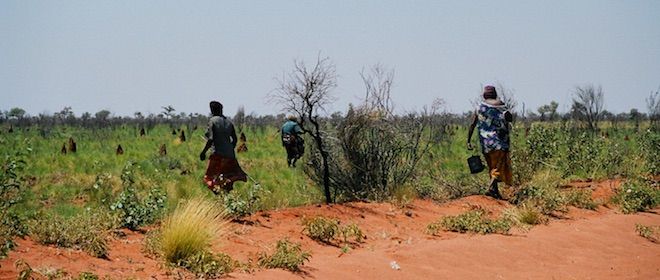
Above: Wild harvesters searching for akatyerr (bush tomatoes) near Ti Tree. Photo by Fiona Walsh.
By KIERAN FINNANE
Last updated 2 March 2018, 11am.
It was lunchtime at the bush foods workshop. On the menu – kangaroo satays, roasted cold beef crusted with wattle seed dukkah, potato salad with a wattle seed dressing and a green salad with quandongs and a wild rosella dressing.
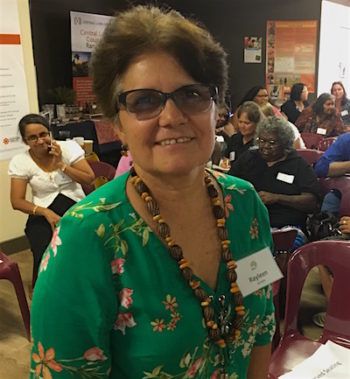 The on-theme spread all came from the kitchen of Kungkas Can Cook, the long-lived catering business of Rayleen Brown (at left), Arrernte woman and trail-blazer in the bush foods industry.
The on-theme spread all came from the kitchen of Kungkas Can Cook, the long-lived catering business of Rayleen Brown (at left), Arrernte woman and trail-blazer in the bush foods industry.
The workshop, called “Growing the Growers” *, was held over two days in the function room of her catering business and brought together some 70 harvesters, who had the program to themselves on the first day and were then joined by traders, manufacturers, producers and some government representatives, including, briefly, the Minister for Agriculture, Ken Vowles.
Ms Brown, who has worked with women doing wild harvest of bush foods for the last 10 to15 years, welcomed the attention being given to them at last.
A lot of the focus in the past – for instance through the research projects of Ninti One (formerly Desert Knowledge Cooperative Research Centre) and on various industry boards around the country – was “around the top of the value chain”, she said.
“There was nothing to really help the women on community and I haven’t really seen a change.”
It was the Giles Government which announced in its 2016 budget a $500,000 commitment for a bush tucker research and development study to establish a national industry hub in Alice Springs, work which is ongoing under Labor.
Ms Brown is always the local go-to person for this industry, having built her flourishing business against the odds and with an unwavering commitment to bush foods. She said she was asked where the value in the industry in the NT is coming from.
“I said straight away, it’s coming from women on country. We don’t need to look to factories or the big business owners making lots of money.
“We need to concentrate on how do we support these women out on communities, how do we protect their intellectual property rights, or Indigenous ecological knowledge (IEK) as it’s now known? How do they get a fair piece of the pie?”
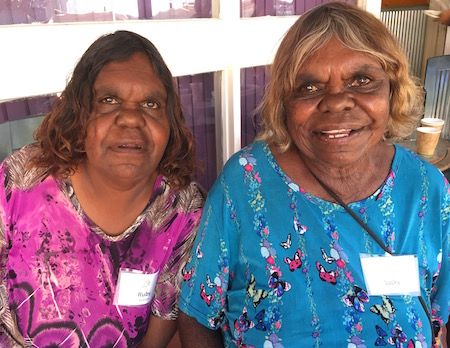 These are women like sisters Ruby and Lucky Morton (at right), Alyawarr women from the Utopia Homelands, who were among the harvesters attending the workshop.
These are women like sisters Ruby and Lucky Morton (at right), Alyawarr women from the Utopia Homelands, who were among the harvesters attending the workshop.
The wild harvest they describe is hard work and getting harder. They now have to travel “long way, walking there, might be in a little car” to find the plants. They speak of several trips – “three day must be, four day, go there, come back afternoon” – cutting, collecting, cleaning the harvest. End result from their last forays, just two bucketsful of akatyerr (bush tomatoes) for which they were paid $300.
Was that a good price? “No,” said Ruby.
The man they sold it to agreed. Rod Horner (below left) was at the workshop too. He’s been buying from wild harvesters in that part of the country for more than forty years. He’d love to see them getting a better return, but it is limited by what he can get for it.
Does he think he has seen the limit in terms of a wholesale price?
“It will creep up over time, as it has in the past, with more people buying it,” said Mr Horner.
His buyers are from the bush foods industry that has emerged during recent decades, as well as, in the case of wattle seed, the mining industry who use the seed for rehabilitation of mining sites.
Ms Brown believes that better promotion in the bush foods industry of wild harvest products as really ethical products could and should attract a premium price.
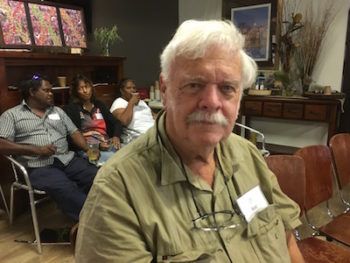 Money, however, is not the only benefit the Morton sisters speak of.
Money, however, is not the only benefit the Morton sisters speak of.
Harvesting is a way of spending time on their country around the family outstation known as Rocket Range: “One country, one father.”
There they also collect plants for bush medicine, preparations they were taught by their mother, medicine for kidneys, for coughs.
And it’s a way of staying in touch with the inspiration for their paintings. Both of them are sought-after artists with work in national, and for Lucky, international collections.
Importantly too, they take young people with them when they go looking for bush foods:
“Young girl, yeah,” said Lucky, “and Ruby’s grandson, go there, cut ‘im. ‘Ruby, I’m cut ‘im tree down,’ young girl talking. ‘Yeah, you cut ‘im that one too,’ Ruby talking.”
Do the young people like it?
“Yeah!” the sisters said in unison.
Some of the harvest they keep for themselves, whether akatyerr or the seed of the mulga tree: “For making damper, kids eating. Akatyerr too makes damper, nice one,” said Lucky.
In these ways they accomplish many of the goals for the grassroots industry that Ms Brown speaks of: a social enterprise generating income, the transfer of knowledge to young people, the use of bush foods in their own diet.
But they face some very big challenges, the most fundamental being that country is getting “weaker”.
“We want access to fighting the buffel out there which is taking over country, it’s a terrible curse,” said Ms Brown.
“I was out there last June, on one side of the road you could see the buffel, on the other side the spinifex, it’s like a wave coming. It’s going to affect the bush foods, the mulga trees and the akatyerr.
“They are also worrying about the rules around burning. They don’t want to get into trouble from the police but they need to burn the country to get the akatyerr to grow.” (See photo at bottom.)
There’s a lot of talking to do: with Bushfires NT, with the surrounding pastoral leases which favour buffel grass, with the Federal Government which supports ranger programs:
“In the areas where the bush foods are being harvested, they don’t have ranger programs, so that’s a difficulty in itself. The ladies want all their young men to do that, it is men’s work to do the burning.”
(This is so on Alyawarr lands, that burning is seen as men’s work, but on other lands women traditionally had active roles in burning practices for food production and continue to do so, as traditional owners and as rangers.)
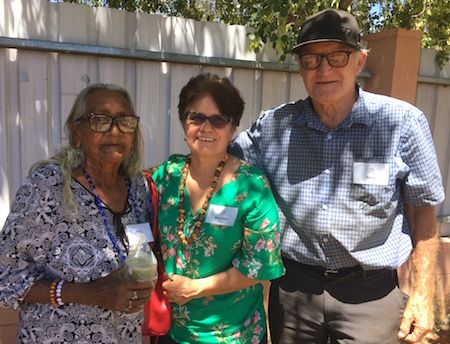 Burning is essential for akatyerr – it deposits carbon in the soil, as grower Max Emery explained to the workshop. After much trial and error he has succeeded in growing akatyerr commercially, with fire delivering the breakthrough.
Burning is essential for akatyerr – it deposits carbon in the soil, as grower Max Emery explained to the workshop. After much trial and error he has succeeded in growing akatyerr commercially, with fire delivering the breakthrough.
Right: Max Emery with his wife Ruth and Rayleen Brown.
But firing buffel grass-infested country is dangerous: “They are such hot fires,” said Ms Brown, “leaving big rocks of coals in the ground, those roots in the ground burn for days!
“We know pastoralists love the buffel but for us to get an economy off our land we need to fight it. How do we do that hand in hand?
“We have the right to make money off our lands as well. That needs to be another discussion.”
Meanwhile, strengthening knowledge transmission to young people could also do with some help.
“The women are saying the only way we can teach our young people about bush foods and medicines is through language, but there are no supported bi-lingual curriculum in the schools any more.
“What they’d like to see, what I’d really like to see, is a whole unit of work based around secondary school kids going out to work with the ladies, learning harvesting techniques, management techniques, getting kids ready to go on to be rangers, looking after country, knowing the seasons for bush foods, when the wattles are ready, when the akatyerr grows.”
That knowledge of seasons is an important, under-recognised element in the work of the wild harvesters.
The Morton sisters haven’t harvested anything for sale since last year.
“Dry one … waiting now, bush tucker, waiting, nothing now,” said Lucky Morton.
Said Ms Brown: “I always get told when I come, ‘It’s hard work, Rayleen.’ Even when I drop a seed on the ground, they scoop it up, ‘It’s hard work, don’t drop even one seed!’
“How many months has it been watching those trees? If they can see a storm coming and they know the trees are ready, they’ll rush out and try to get the seed before the storm hits. It’s months of preparation, watching, going out with the kids. They reckon ‘Our kids are sick of it!’ but they say, ‘They’ll learn, we’re teaching them.’ (See photo at bottom.)
“It would be such a pity if we lose this. It’s more than food, it’s got so many connections to people, it’s the fibre of people, it’s who they are.”
The women are not asking for “a handout of money”, she said, but rather for those “many layers” of external supports that she has described.
She welcomed the workshop as an occasion for getting some of “the right ears in the room”, to recognise wild harvest as “a really important activity on country” that has to have a place in what is turning into a multi-million dollar industry.
*The “Growing the Growers” workshop was funded by Australian Native Foods and Botanicals (ANFAB) with Chair, Amanda Garner, and staff contributing. The two day event was co-organised by Donna Digby, Bush products Development Officer with the NT Government’s Department of Primary Industry and Rayleen Brown of Kungkas Can Cook. The Department funded the Harvesters workshop with support and contributions from Central Land Council, Traditional Owners and Aboriginal rangers.
Below, photos by Fiona Walsh, who facilitated the workshop:
An area known as the ‘Akatyerr Farm’ for its once bountiful harvest of the plant, now unmanaged and overgrown by spinifex. Akatyerr needs cool light burns and rainfall to promote its production.

Three generations of the Holmes family harvesting Ilkerte (wattle seed) near Ampilatwatja.
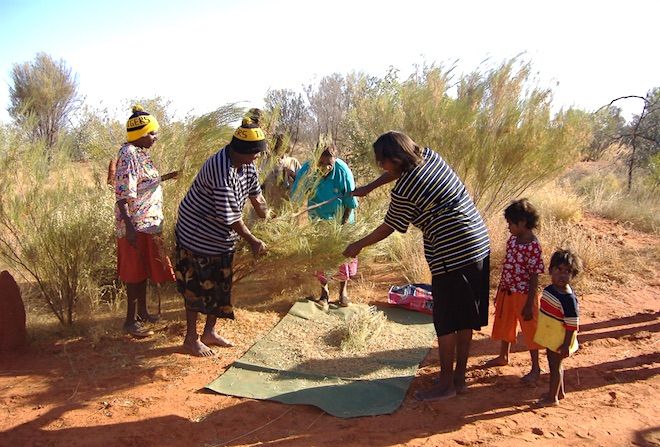



Good one.